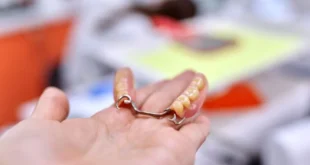Periodontitis, commonly known as gum disease, is a prevalent oral health issue affecting millions globally. This comprehensive guide delves deeper into periodontitis, providing valuable insights into its causes, symptoms, treatment options, and preventive measures.

What is Periodontitis?
Periodontitis represents an advanced stage of gum disease characterized by inflammation and infection of the gums and surrounding tooth structures. It typically originates from gingivitis, where gums become inflamed, red, and prone to bleeding, but if left untreated, it escalates into periodontitis, leading to irreversible damage to the gums and bone.
How Common is Periodontitis?
Is alarmingly widespread, impacting a significant portion of the global population. Studies suggest that approximately 47.2% of adults aged 30 years and older in the United States alone suffer from some form of periodontal disease. Moreover, the prevalence escalates with age, affecting over 70% of adults aged 65 and above.
Symptoms and Causes
Recognizing the symptoms of periodontitis is crucial, including swollen, tender, or bleeding gums, persistent bad breath, receding gums, loose teeth, and gum bleeding during brushing or flossing. The primary cause of periodontitis is inadequate oral hygiene, leading to the buildup of plaque and tartar along the gumline. Additionally, smoking, hormonal fluctuations, certain medications, and genetic factors can exacerbate the condition.
What Happens if Periodontal Disease Goes Untreated?
Neglecting periodontal disease can result in severe consequences, such as tooth loss, bone degradation, and systemic health complications. The inflammation and bacterial infection associated with periodontitis can infiltrate the bloodstream, elevating the risk of cardiovascular diseases, diabetes complications, respiratory infections, and other systemic issues.
Diagnosis and Tests
Accurate diagnosis of periodontitis typically involves a thorough dental examination, encompassing visual assessment of the gums, measurement of pocket depths between gums and teeth, dental X-rays to evaluate bone loss, and additional diagnostic tests like bacterial culture or DNA testing.
Management and Treatment
Effectively managing periodontitis involves controlling the infection, arresting disease progression, and restoring gum and bone health. Common treatment modalities encompass professional dental cleaning (scaling and root planing), administration of antibiotics, antimicrobial mouth rinses, and surgical interventions such as flap surgery or tissue grafting in severe cases.
Prevention
Preventing periodontitis begins with adopting and adhering to good oral hygiene practices, including regular brushing, flossing, and scheduling routine dental check-ups and cleanings. Avoiding tobacco use, maintaining a balanced diet rich in essential nutrients, and effectively managing underlying health conditions like diabetes are also pivotal in preventing periodontal disease onset and progression.
In conclusion, periodontitis demands vigilant attention and proactive management to avert its detrimental consequences. Armed with knowledge about its causes, symptoms, and treatment options, individuals can take proactive steps to safeguard their oral health and overall well-being. Remember, early detection, intervention, and consistent oral care are paramount in preserving a healthy smile and enhancing quality of life.
 Tu Casa En Calgary
Tu Casa En Calgary




